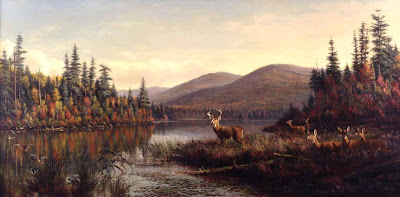 Two new exhibits have opened at the Adirondack Museum: “The Adirondack World of A.F. Tait” and “Night Vision: The Wildlife Photography of Hobart V. Roberts.”
Two new exhibits have opened at the Adirondack Museum: “The Adirondack World of A.F. Tait” and “Night Vision: The Wildlife Photography of Hobart V. Roberts.”
Arthur Fitzwilliam Tait was the classic artist of Adirondack sport. “The Adirondack World of A.F. Tait” features paintings and prints depicting life in the Adirondack woods – images of hunters, sportsmen, guides, and settlers that include a wealth of historical detail. An ardent sportsman and lover of the outdoors, Tait lived in the region for extended periods of time near Chateaugay, Raquette and Long lakes.
His images of animals and sporting adventures were among the best known in 19th-century America thanks to Currier & Ives, whose lithographs of Tait paintings helped popularize the Adirondacks as a sportsman’s paradise.
Chief Curator, Laura Rice called the exhibit, “a rare opportunity to see some of Tait’s most important works, including a few from private collections which are rarely, if ever, on exhibit.”
“Night Vision: The Wildlife Photography of Hobart V. Roberts” focuses on the work of one of the nation’s most recognized amateur wildlife photographers in the first decades of the 20th century. Roberts’ Adirondack wildlife photographs represent an important breakthrough in science and the technology of photography. He developed a thorough knowledge of Adirondack
wildlife and their habits, and deer jacking inspired him to consider night photography. A feature article in the New York Times, August 26, 1928, described Roberts’ as “hunting with a camera in the Adirondacks.”
The “Night Vision” exhibit features approximately 35 original large-format photographs of Adirondack wildlife. Roberts’ cameras, equipment, colored lithographic prints, hand-colored transparencies, published works, and his many awards will also be exhibited. His work has been published in Audubon Magazine, Country Life, Modern Photography, and The National Geographic
Magazine.
The museum is open through October 17, 2011, from 10 a.m. to 5 p.m., 7 days a week, including holidays. There will be an early closing on August 12, and adjusted hours on August 13- the museum will be closed on September 9. Visit www.adirondackmuseum.org for more information. All paid admissions are valid for a second visit within a one-week period.








